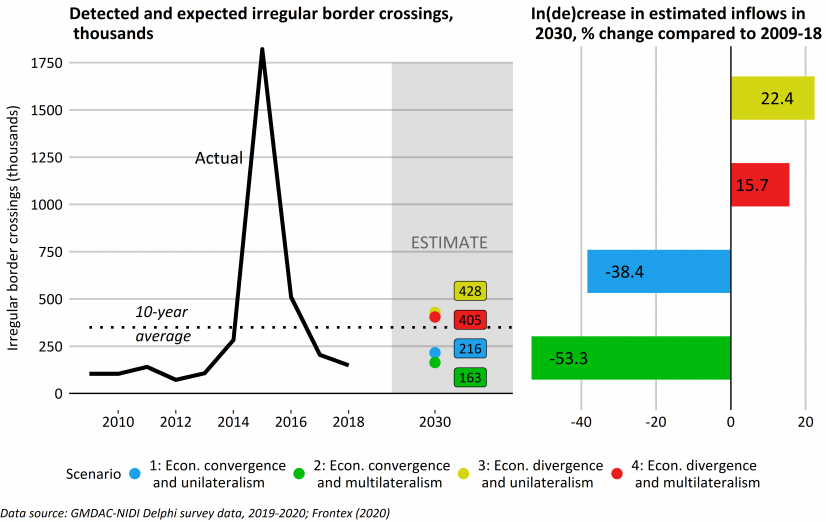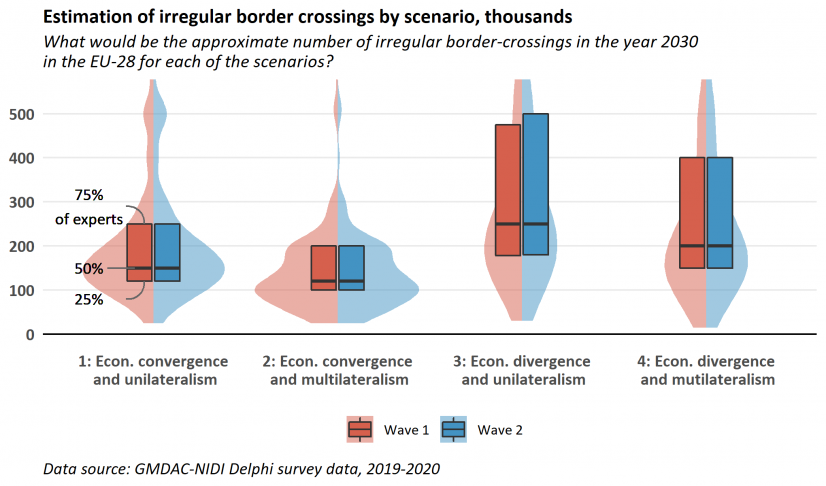Forecasts, predictions, projections, foresight, scenarios, and Delphi methods. Approaches to help anticipate the future of migration are not just in high demand; they are also increasingly difficult for policymakers to navigate. This blog aims to situate forecasting methods in a wider family of approaches, highlight key differences, advantages and disadvantages, and illustrate the difficult tradeoffs inherent in discussing future migration using results from own recent expert survey conducted in partnership with the Netherlands Interdisciplinary Demographic Institute (NIDI).
Three main approaches
It’s helpful to generally distinguish three broad approaches: Forecasts, foresight (or scenarios) and early-warning systems.
Forecasts
Forecasts produce a quantitative estimate of future migration. Forecasts, predictions, projections can broadly be used interchangeably. Throwing these terms together might make some experts cringe. Of course, there are differences, but some more important commonalities.
The underlying source of forecasting approaches (i.e. past data) is also the main limitation of forecasts: Past migration data are often not available at all, only available for certain years or countries, spotty, of insufficient quality, and not comparable. That is one of the reasons why GMDAC exists and why many experts on our advisory board have dedicated their careers to migration data.
Foresight – or scenarios
Foresight is quite different from forecasts in that it requires less statistics and more imagination. Foresight (or often called scenarios) are qualitative narratives about the future of migration that emphasize possible structural changes and their consequences for migration—a “what if…” approach. Scenarios don’t claim to become real, they aim to be plausible and push experts and policymakers to think outside the box (Vezzoli et al., 2017). Scenarios draw on a practitioner-driven, strategic, iterative (repeating steps and improving the scenario over time) and discursive (i.e. experts talking to each other) methodology. Migration scenarios have been a popular approach in the migration field in the recent decade (see Sohst et al, forthcoming).
The key limitation of foresight is also its main underlying data: the experts themselves. Experts bring their own “cognitive biases” (i.e. their very own idea of what is real and what isn’t). The second limitation is that scenarios often aren’t of timely use to policymakers that need to make decisions now. While it is interesting and stimulating to consider different future scenarios, it provides less action-oriented advice.
Early warning systems
Early warning systems monitor migration trends or potential drivers of migration and forced displacement in real time, with the goal of signaling surges in migration to policymakers with as much advance warning as possible (Schmidt and Hooper, forthcoming). Early warning systems select a set of “indicators” (e.g. how many people cross the border every week) and establish a number of thresholds (i.e. how many people need to cross the border per month before we do something) to automatically set in motion a pre-determined protocol of action.
Early warning systems use frequently updated data from a variety of sources including quantitative (e.g. migration flows, incidences covered in news media, social media etc.) and qualitative (e.g. expert judgment on warning thresholds) information. Early warning systems are a useful tool to react to situations on the ground and pre-emptively commit or re-allocate resources. There are several key challenges: First, it is difficult to know which “indicators” are meaningful and which thresholds are relevant. Second, data collection has to be highly consistent and standardized to make sure indicators do not just go up because the way the data has been collected has changed.
Characteristics of three common approaches to anticipate future migration:
| Forecasts | Foresight/scenarios | Early warning systems | |
|---|---|---|---|
| Time horizon | Variable | Long-term | Short-term |
| Tangible results | Yes | No | Yes |
| Quantifies uncertainty | Yes | No | No |
| Relies on numerical data | Yes | No | Partly |
| Relies on experts | No | Yes | Partly |
| Feasibility | Low to medium | High | Medium |
| Cost | Depends | Low | Medium |
| Key audience | Policymakers, academics | Decision-makers | Practitioners, operational staff |
A common enemy
All described approaches face a common enemy: uncertainty. Each approach uses different tools to make the future a little more controllable and a little less nerve-wrecking. None of them have proven to be particularly successful in anticipating the future.
We will only hear about forecasts when they were wrong or when they were right but ignored. Forecasts do not a have a track record of being accurate, but when they are, it’s a whole other question whether policymakers and politicians react to them. When they are wrong—and they often are wrong (ask economists)—the trust in experts suffers.
Scenarios have it easier since we won’t know anytime soon whether they will turn out to be right or not. Early warning systems, on the other hand, lose sight of the bigger picture. They don’t tell use why certain indicators go up or down and how to be best prepare. Like measuring a fever, they just tell us when it’s time to act quickly.
History—particularly migration history—has shown time and again, that large population movements are often a result of single, hard-to-predict events such as large economic or political shocks (De Haas, 2011). Think for example about the recent political events in the Arab Republic of Syria, the Bolivarian Republic of Venezuela, Libya, or the current coronavirus crisis. Few imagined that these events could happen, but they had great implications for migratory dynamics.
Can experts help? Recent survey results
Beyond the three broader approaches outlined above, there are some methods that combine different aspects. One of them is a Delphi survey. A Delphi survey collects numeric data via surveys with experts. The experts provide their own subjective estimates for the future. The analysis is quantitative, but no forecasting models, statistical predictions or projections are applied.
Rather than asking experts directly what the future will hold, GMDAC and NIDI recently presented four different scenarios to 178 experts. They then estimated the implications of each scenario for various migrations flows to the EU in 2030 (Acostamamiedo et al., 2020). Experts appear to agree on broader trends.
- On average, most experts think that in 2030, total yearly immigration flows will increase, depending on the scenario, between 21 and 44 per cent compared to the average total inflows between the 2008-17 period.
- High-skilled migration is expected to increase most dramatically.
- Irregular migration is expected to be similar to the trend in the last 10 years (see Figure 1 below) but generally there is more uncertainty how the economy and international cooperation affect this particular flow. However, these expected increases, compared to the yearly average level between 2009-18, are still dramatically lower than the number of irregular border crossings during the perceived “migration crisis” in 2015-16.
Figure 1.
The survey results also show that experts are not very confident in their responses and disagree substantially about what the future will hold. On a scale from 1 to 100, the average level of confidence in their own prediction was 41. When experts were shown the average estimations of their peers, only nine per cent adjusted their original opinion. In some scenarios, half of the experts’ estimated future irregular border crossings differed by an amount of 285,000 people—more than all annual border crossings recorded to the European Union (EU) in 2018.
Figure 2.
While experts agree on broader trends, they disagree on the number and type of migrants that may come to the EU in 2030. They are not very confident in their predictions and are not likely to change their opinions when confronted with the views of their peers. Where does this leave us? What can policymakers take away from that exercise?
Decision makers request less ambiguous advice to guide policy (Aspinall, 2010). If policymakers use experts to inform policies, they have to remind themselves that they are dealing with people that have their own subjective view of the world—or “cognitive biases” (Morgan, 2014; Sutherland and Burgman, 2015; Tetlock, 2017). Even providing them with different scenarios instead of letting their imagination run free does not increase consensus. Expert-led scenarios are not the policymakers’ tool of choice when action-oriented, operational input is needed. However, they can be a valuable tool for strategic “big-picture” thinking, especially when decision makers themselves take part in them. Expert opinion provides a more nuanced picture, pinpoints areas with more and less uncertainty and as such enables preparedness.
Future migration scenarios are a good reminder that policymakers will always struggle to anticipate key changes in migration flows but that it’s more important to set up systems that can deal with different alternative outcomes and adjust flexibly.
Authors’ note: We hope that this short blog piece was able to provide more clarity on different approaches to anticipating future migration. Each approach has their strengths and limitations. Different methods may be appropriate for different situations and policy needs, yet they are similar in the fact that they all come with large uncertainty – quantified (in the casts of forecasts) or not (in the case of scenarios). Results from the expert survey were developed in the context of the CrossMigration project – a EU-Horizon funded research project.
Read the full report with interactive visualizations.
Consult the Global Migration Data Portal’s Migration forecasting and scenarios thematic page for more resources.
Disclaimer: The opinions expressed in this blog are those of the authors and do not necessarily reflect the views of the International Organization for Migration (IOM) or the United Nations. Any designations employed and the presentation of material throughout the blog do not imply the expression of any opinion whatsoever on the part of IOM concerning the legal status of any country, territory, city or area, or of its authorities, or concerning its frontiers and boundaries.
| Acostamadiedo et al. | |
| 2020 |
Assessing immigration scenarios for the European Union in 2030 - Relevant, realistic, reliable? International Organization for Migration, Netherlands Interdisciplinary Demographics Institute, Geneva. |
|
Aspinall, W. |
|
| 2010 |
A route to more tractable expert advice. Nature, 463(7279):294–295. |
|
Bijak, J. |
|
| 2011 | Forecasting International Migration in Europe: A Bayesian View. Springer Series on Demographic Methods and Population Analysis 24. |
| Carammia, M. and Dumont, J. | |
| 2018 |
Can we anticipate future migration flows? OECD/EASO Migration Policy Debate N.16. |
|
De Haas, H. |
|
| 2011 | Mediterranean migration futures: Patterns, drivers and scenarios. Glob. Environ. Change 21, S59–S69. doi:10.1016/j.gloenvcha.2011.09.003. |
|
Disney, G. et al. |
|
| 2015 | Evaluation of existing migration forecasting methods and models. Report for the UK Migration Advisory Committee. ESRC Centre for Population Change, University of Southampton. |
| International Organization for Migration | |
| 2016 |
Migration forecasting: Beyond the limits of uncertainty. Global Migration Data Analysis Centre (GMDAC). Data Briefing Series No. 6. |
| Sardoschau, S. | |
| 2020 |
The Future of Migration to Germany. Assessing Methods in Migration Forecasting. DeZIM Project Report #DPR 1|20 Berlin. |
|
Schmidt, T. and K. Hooper |
|
| Forthcoming |
Preparing for Future Migration Trends – Using forecasting and scenario-building for forward-looking policies. Working paper, Migration Policy Institute Europe, Brussels. |
|
Sohst et al. |
|
| 2020 |
The Future of Migration to Europe: A Systematic Review of the Literature on Migration Scenarios and Forecasts. International Organization for Migration, Netherlands Interdisciplinary Demographics Institute, Geneva. |
|
Sutherland, W. J., M. Burgman |
|
| 2015 | Policy advice: use experts wisely. Nature Comments, 15 October 2015. |
|
Tetlock, P. |
|
| 2017 |
Expert political judgment: How good is it? How can we know? New edition. Princeton University Press. |
| Vezzoli, S. et al. | |
| 2017 | Global migration futures - Exploring the future of international migration with a scenario methodology. University of Oxford, International Migration Institute Working Papers, 135. |








